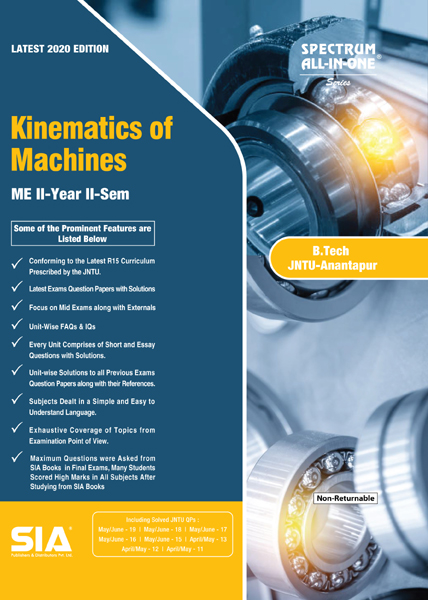

Note: Please check your Spam or Junk folder, in case you didn't receive the email with verification code.
SYLLABUS
UNIT-I
MECHANISMS AND MACHINES Elements or Links – Classification – Rigid Link, Flexible and fluid link. Types of kinematic pairs – Sliding, Turning, rolling, Screw and spherical pairs – Lower and higher pairs – Closed and open pairs – Constrained motion – Completely, Partially or successfully constrained and incompletely constrained. Mechanisms and machines – Classification of mechanisms and machines – Kinematic chain – Inversion of mechanisms – Inversions of quadric cycle chain – Single and double slider crank chain. Mobility of mechanisms. Straight Line Motion Mechanisms - Exact and approximate, Copiers and generated types – Peaucellier, Hart and Scott Russel – Grasshopper, Watt, Tchebicheff and Robert Mechanisms, Pantograph.
UNIT-II
STEERING MECHANISMS Conditions for correct steering – Davis Steering gear, Ackermanns steering gear. Hooke’s Joint (Universal coupling) -Single and double Hooke’s joint – Applications – Simple problems. Belt, Rope and Chain Drives : Introduction, Belt and rope drives, Selection of belt drive - Types of belt drives, Materials used for belts and ropes, Velocity ratio of belt drives, Slip of belt, Creep of belt, Tensions for flat belt drive, Angle of contact, Centrifugal tension, Maximum tension of belt, Chains - Length, Angular speed ratio, Classification of chains.
UNIT-III
KINEMATICS Velocity and acceleration diagrams – Velocity and acceleration – Motion of link in machine – Determination of Velocity and acceleration – Graphical method – Application of relative velocity method – Slider crank mechanism, four bar mechanism. Acceleration diagrams for simple mechanisms, Coriolis acceleration, Determination of Coriolis component of acceleration. Kleins construction. Analysis of slider crank mechanism for displacement, Velocity and acceleration of slider using analytical method. Instantaneous Centre Method: Instantaneous centre of rotation, Centrode and axode – Relative motion between two bodies – Three centres in-line theorem – Locating instantaneous centres for simple mechanisms and determination of angular velocity of points and links.
UNIT-IV
GEARS Higher pairs, Friction wheels and toothed gears – Types – Law of gearing, Condition for constant Velocity ratio for transmission of motion, Forms of tooth - Cycloidal and involute profiles. Velocity of sliding – Phenomena of interference – Methods to avoid interference. Condition for minimum number of teeth to avoid interference, Expressions for arc of contact and path of contact. Introduction to Helical, Bevel and worm gearing. Syllabus GEAR TRAINS Introduction –Types of gears – Simple, Compound, Reverted and Epicyclic gear trains. Train value – Methods of finding train value or velocity ratio – Tabular column method for Epicyclic gear trains. Torque in epicyclic gear trains. Differential gear of an automobile.
UNIT-V
CAMS Definitions of cam and follower – Uses – Types of followers and cams – Terminology. Types of follower motion - Uniform velocity – Simple harmonic motion and uniform acceleration. Maximum velocity and maximum acceleration during outward and return strokes. Drawing of cam profiles. ANALYSIS OF MOTION OF FOLLOWERS Tangent cam with roller follower – Circular arc (Convex) cam with flat faced and roller follower.
 No Preview is available for this book
No Preview is available for this book

 Get 100 instant uPoints on the purchase of Rs.100 or above for each order.
Get 100 instant uPoints on the purchase of Rs.100 or above for each order.
CategoriesEngineering

Format EPUB

TypeeBook